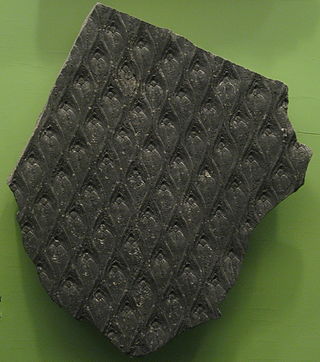
Lepidodendron is an extinct genus of primitive lycopodian vascular plants belonging the order Lepidodendrales. It is well preserved and common in the fossil record. Like other Lepidodendrales, species of Lepidodendron grew as large-tree-like plants in wetland coal forest environments. They sometimes reached heights of 50 metres, and the trunks were often over 1 m (3.3 ft) in diameter. They are often known as "scale trees", due to their bark having been covered in diamond shaped leaf-bases, from which leaves grew during earlier stages of growth. However, they are correctly defined as arborescent lycophytes. They thrived during the Carboniferous Period, and persisted until the end of the Norian around 208 million years ago. Sometimes erroneously called "giant club mosses", the genus was actually more closely related to modern quillworts than to modern club mosses. In the form classification system used in paleobotany, Lepidodendron is both used for the whole plant as well as specifically the stems and leaves.
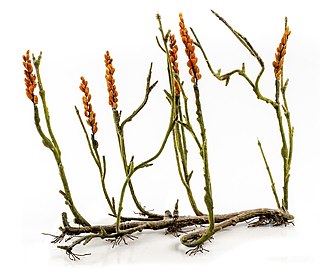
The zosterophylls are a group of extinct land plants that first appeared in the Silurian period. The taxon was first established by Banks in 1968 as the subdivision Zosterophyllophytina; they have since also been treated as the division Zosterophyllophyta or Zosterophyta and the class or plesion Zosterophyllopsida or Zosteropsida. They were among the first vascular plants in the fossil record, and had a world-wide distribution. They were probably stem-group lycophytes, forming a sister group to the ancestors of the living lycophytes. By the late Silurian a diverse assemblage of species existed, examples of which have been found fossilised in what is now Bathurst Island in Arctic Canada.

Asteroxylon is an extinct genus of vascular plants of the Division Lycopodiophyta known from anatomically preserved specimens described from the famous Early Devonian Rhynie chert and Windyfield chert in Aberdeenshire, Scotland. Asteroxylon is considered a basal member of the Lycopsida.
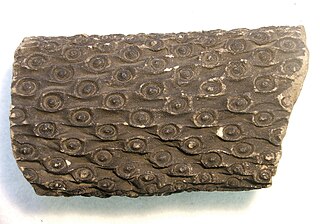
Stigmaria is a form taxon for common fossils found in Carboniferous rocks. They represent the underground rooting structures of arborescent lycophytes such as Sigillaria and Lepidodendron under the order Lepidodendrales.
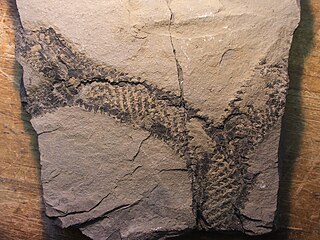
Lepidodendrales or arborescent lycophytes are an extinct order of primitive, vascular, heterosporous, arborescent (tree-like) plants belonging to Lycopodiopsida. Members of Lepidodendrales are the best understood of the fossil lycopsids due to the vast diversity of Lepidodendrales specimens and the diversity in which they were preserved; the extensive distribution of Lepidodendrales specimens as well as their well-preservedness lends paleobotanists exceptionally detailed knowledge of the coal-swamp giants’ reproductive biology, vegetative development, and role in their paleoecosystem. The defining characteristics of the Lepidodendrales are their secondary xylem, extensive periderm development, three-zoned cortex, rootlike appendages known as stigmarian rootlets arranged in a spiralling pattern, and megasporangium each containing a single functional megaspore that germinates inside the sporangium. Many of these different plant organs have been assigned both generic and specific names as relatively few have been found organically attached to each other. Some specimens have been discovered which indicate heights of 40 and even 50 meters and diameters of over 2 meters at the base. The massive trunks of some species branched profusely, producing large crowns of leafy twigs; though some leaves were up to 1 meter long, most were much shorter, and when leaves dropped from branches their conspicuous leaf bases remained on the surface of branches. Strobili could be found at the tips of distal branches or in an area at the top of the main trunk. The underground organs of Lepidodendrales typically consisted of dichotomizing axes bearing helically arranged, lateral appendages serving an equivalent function to roots. Sometimes called "giant club mosses", they are believed to be more closely related to extant quillworts based on xylem, although fossil specimens of extinct Selaginellales from the Late Carboniferous also had secondary xylem.

Nepenthes andamana is a tropical pitcher plant endemic to Phang Nga Province, Thailand, where it grows near sea level in coastal savannah and grassland. It is thought to be most closely related to N. suratensis.
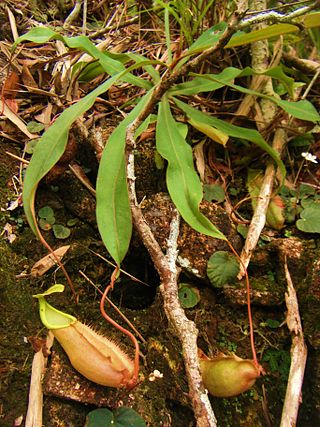
Nepenthes chang is a tropical pitcher plant endemic to the Banthad Mountains of central Thailand, where it grows at elevations of 300–600 m above sea level. It is thought to be most closely related to N. kampotiana.

Nepenthes leonardoi is a tropical pitcher plant known from a single locality in central Palawan, the Philippines. It is closely allied to several other Palawan endemics, including N. deaniana, N. gantungensis, and N. mira. The traps of this species reach at least 24 cm in height. Some specimens are noted for producing very dark, almost black, upper pitchers.

Adoketophyton is a genus of extinct vascular plants of the Early Devonian. The plant was first described in 1977 based on fossil specimens from the Posongchong Formation, Wenshan district, Yunnan, China. These were originally named Zosterophyllum subverticillatum; later the species was transferred to a new genus as Adoketophyton subverticillatum. One cladistic analysis suggested that it is a lycophyte, related to the zosterophylls. Other researchers regard its placement within the vascular plants as uncertain.
Rotafolia is a genus of the extinct Sphenophyllales horsetails. The species Rotafolia songziensis was first described as Bowmanites songziensis in 1984, based on a fossilized strobilus, and transferred to the new genus Rotafolia in 2005.

The Bokkeveld Group is the second of the three main subdivisions of the Cape Supergroup in South Africa. It overlies the Table Mountain Group and underlies the Witteberg Group. The Bokkeveld Group rocks are considered to range between Lower Devonian (Lochkovian) to Middle Devonian (Givetian) in age.
Ramoferis is a genus of extinct vascular plants of the Pragian stage of the Early Devonian, around 411 to 408 million years ago. It is considered to be a zosterophyll, one of a group of plants that were related to the ancestors of the modern lycopsids. Fossils were found in the Posongchong Formation in Guangnan County, Yunnan, in southwestern China, where they occur as compressions.

The Waterloo Farm lagerstätte is a Famennian lagerstätte in South Africa that constitutes the only known record of a near-polar Devonian coastal ecosystem.
Hexachara is a genus of fossil charophyte that is likely to have formed meadows within sheltered oligohaline reaches of lakes.

Octochara is a genus of fossil charophyte from the Famennian. It is one of two genera of charophyte described from the Waterloo Farm lagerstätte in southern Africa. It and Hexachara, from the same locality provide the oldest record of reconstruct able charophytes with in situ oogonia.

Isityumzi mlomomde is fossil lungfish described from fragmentary remains including one complete parasphenoid, tooth plates fragments and scales from the Late Devonian Sarcopterygians. It represents the only record of Late Devonian lungfish remains from western Gondwana.

Hungerfordia is a genus of presumed marine algae first described by Fry and Banks in 1955 in describing Hungerfordia dichotoma from Late Devonian strata. It has been interpreted as a probable brown (Phaeophyte) algae though the possibility that it represents a red (Rhodophyte) alga is not excluded - the taxonomic challenge being that modern red and brown algae are differentiated on the basis of colour and cellular structure which are not preserved in the fossil taxa. Douglas and Jell (1985) suggested that Buthotrephis trichotoma and B. divaricata should furthermore be transferred from Buthotrephis to Hungerfordia.
Yeaia is an extinct genus of brown algae known from the Silurian and Devonian of southern hemisphere locations.
Leptophloeum is an extinct genus of vascular plants in the lycophyte clade. It is widely distributed being, known from the Laurasian and Gondwanan settings between the Devonian and Early Carboniferous periods.

Rinistachya is a genus of Late Devonian sphenopsid, currently containing one species, Rinistachya hilleri. It comprises the only sphenopsid as yet known from the Devonian of Gondwana, and is currently known from only a small number of specimens collected from the main fish layer/lens (MFL) black shale within the Witpoort Formation at Waterloo Farm, Makhanda. It is currently interpreted as a small-sized herbaceous plant. and 'exhibits a novel architecture' that includes apparently plesiomorphic characters, reminiscent of the organisation of the Iridopteridales. Other characters unambiguously nest Rinistachya within the Sphenopsida. This provides strong support for a close relationship between Sphenopsida and Iridopteridales. It is the only known high latitude sphenopsid known from the Devonian, the only other 3 genera, Eviostachya, Hamatophyton and Rotafolia being of palaeotropical provenance.














